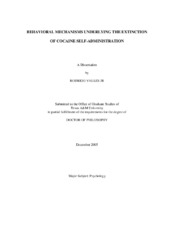| dc.contributor.advisor | Nation, Jack R | |
| dc.creator | Valles, Rodrigo, Jr. | |
| dc.date.accessioned | 2006-04-12T16:02:34Z | |
| dc.date.available | 2006-04-12T16:02:34Z | |
| dc.date.created | 2005-12 | |
| dc.date.issued | 2006-04-12 | |
| dc.identifier.uri | https://hdl.handle.net/1969.1/3105 | |
| dc.description.abstract | The aim of the present series of experiments was to outline the influence of
different doses of cocaine during training, training schedule, training length and
abstinence duration to modulate subsequent extinction and reinstatement patterns.
Abram AmselÂ’s general theory of persistence were used to both design and explain
various aspects of these models.
For Experiment 1, rats self-administered cocaine (0.25, 0.50 or 1.00 mg/kg)
intravenously and were then tested in an extinction preparation using saline infusions (5
days) and then only the stimulus light as the reinforcer (3 days). Experiment 2 examined
schedules by magnitude interactions by training rats on two fixed-ratio (FR) schedules
(FR-1 or FR-10 using either 0.25 or 1.00 mg/kg cocaine). Animals were tested in an
extinction protocol (10 days; no stimulus light) and subsequently tested for reinstatement
(1 day) that utilized presentations of the stimulus light. Experiment 3 addressed the
effects of training length (15 or 30 days of training using either 0.25 or 1.00 mg/kg
cocaine) using the same protocol as in Experiment 2. Experiment 4 examined the modulation potential of two abstinence lengths (15 or 30 days using either 0.25 or 0.50
mg/kg cocaine) using the same conditions as Experiment 2.
Experiment 1 indicated the greatest resistance to extinction using the lowest
training dose (0.25 mg/kg). The removal of saline caused an apparent extinction burst
indicative of reward seeking. Experiment 2 showed that animals trained under partial
reinforcement schedules persisted more during extinction. Furthermore, rats trained
using 1.00 were more resistant than those trained with 0.25 mg/kg. Reinstatement of
drug seeking was more pronounced in rats trained using an FR-10 schedule. Experiment
3 indicated greater resistance to extinction in rats trained for 15 versus 30 days. Rats
trained on 0.50 mg/kg for 30 days showed less cue-induced reinstatement than those
trained for 15 days. Experiment 4 showed increased resistance to extinction when rats
were trained on 0.25 mg/kg and forced to abstain for 30 versus 15 days. Directionally
opposite effects were apparent in groups trained with 0.50 mg/kg. Reinstatement data
indicated greater responsivity to cues by animals abstaining for 30 versus 15 days. | en |
| dc.format.extent | 758517 bytes | en |
| dc.format.medium | electronic | en |
| dc.format.mimetype | application/pdf | |
| dc.language.iso | en_US | |
| dc.publisher | Texas A&M University | |
| dc.subject | Extinction | en |
| dc.subject | Cocaine | en |
| dc.title | Behavioral mechanisms underlying the extinction of cocaine self-administration | en |
| dc.type | Book | en |
| dc.type | Thesis | en |
| thesis.degree.department | Psychology | en |
| thesis.degree.discipline | Psychology | en |
| thesis.degree.grantor | Texas A&M University | en |
| thesis.degree.name | Doctor of Philosophy | en |
| thesis.degree.level | Doctoral | en |
| dc.contributor.committeeMember | Bratton, Gerald R | |
| dc.contributor.committeeMember | Setlow, Barry | |
| dc.contributor.committeeMember | Wellman, Paul J | |
| dc.type.genre | Electronic Dissertation | en |
| dc.type.material | text | en |
| dc.format.digitalOrigin | born digital | en |


